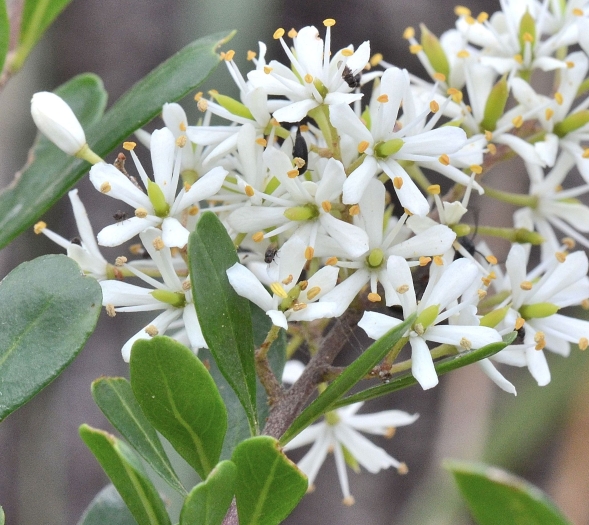Sweet Bursaria
(Bursaria spinosa)
Sweet Bursaria (Bursaria spinosa)
/
/

James Duggan
CC BY 4.0
Image By:
James Duggan
Recorded By:
Copyright:
CC BY 4.0
Copyright Notice:
Photo by: James Duggan | License Type: CC BY 4.0 | License URL: http://creativecommons.org/licenses/by/4.0/ | Occurence ID: https://www.gbif.org/occurrence/1632954046 | Publisher: Atlas of Living Australia |














































































































Estimated Native Range
Summary
Bursaria spinosa, commonly known as Sweet Bursaria, is an evergreen shrub native to a variety of habitats including dry forests, woodland areas, coastal scrubs, and heathlands in Southeastern Australia. It exhibits a highly variable habit, typically ranging from 1 to 12 meters in height. Sweet Bursaria is characterized by its dark grey, deeply furrowed bark and smooth branches that may bear thorns. The foliage is alternately arranged or clustered around the nodes, emitting a pine-like fragrance when bruised. Its small, white, and fragrant flowers are showy and appear predominantly in the summer, although sporadic blooming can occur throughout the year. These flowers are arranged in leafy pyramid-shaped panicles and attract a variety of pollinators.
Sweet Bursaria is valued for its adaptability, fragrant foliage, and flowers that provide a source of nectar for insects and birds. It is used in cultivation for habitat restoration, as a screen or hedge, and in mixed shrub borders. The plant is drought-tolerant once established and can thrive in full sun to part shade. It prefers well-drained soils but is adaptable to various soil types. While generally low-maintenance, it may be susceptible to scale insects and sooty mold. Sweet Bursaria is not known for aggressive roots or significant disease problems. It is also recognized for its cultural significance to Indigenous Australians, who use it for medicinal purposes.CC BY-SA 4.0
Sweet Bursaria is valued for its adaptability, fragrant foliage, and flowers that provide a source of nectar for insects and birds. It is used in cultivation for habitat restoration, as a screen or hedge, and in mixed shrub borders. The plant is drought-tolerant once established and can thrive in full sun to part shade. It prefers well-drained soils but is adaptable to various soil types. While generally low-maintenance, it may be susceptible to scale insects and sooty mold. Sweet Bursaria is not known for aggressive roots or significant disease problems. It is also recognized for its cultural significance to Indigenous Australians, who use it for medicinal purposes.CC BY-SA 4.0
Plant Description
- Plant Type: Shrub
- Height: 10-15 feet
- Width: 10-15 feet
- Growth Rate: Moderate
- Flower Color: Cream, White
- Flowering Season: Summer
- Leaf Retention: Evergreen
Growth Requirements
- Sun: Full Sun, Part Shade
- Water: Medium
- Drainage: Medium
Common Uses
Bird Garden, Hedges, Low Maintenance, Showy Flowers, Street Planting
Natural Habitat
Dry forests, woodland areas, coastal scrubs, and heathlands in Southeastern Australia
Other Names
Common Names: Australian Blackthorn, Christmas Bush, Prickly-Box, Prickly-Pine, Mock Orange
Scientific Names: , Bursaria spinosa, Bursaria spinosa f. grandifolia, Bursaria spinosa var. inermis, Bursaria spinosa var. pantonii, Bursaria pantonii, Bursaria spinosa var. inernis, Bursaria spinosa var. macrophylla, Bursaria spinosa var. normalis, Cyrilla spinosa,
GBIF Accepted Name: Bursaria spinosa Cav.